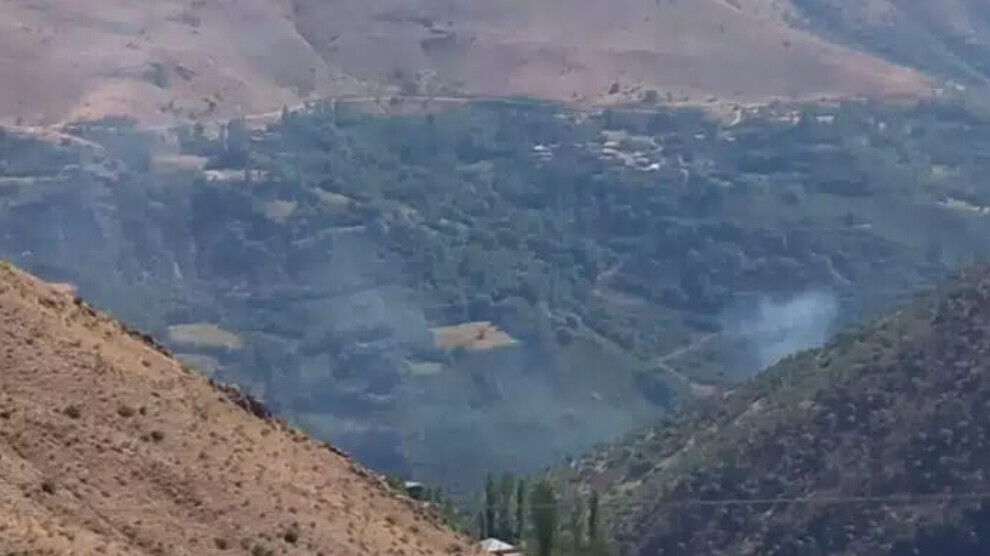AKP's assimilating policy in Bitlis continues
The Turkish state continues to implement a comprehensive plan to assimilate and destroy the northern Kurdish province of Bitlis. Forests are burned, people imprisoned and displaced.
The Turkish state continues to implement a comprehensive plan to assimilate and destroy the northern Kurdish province of Bitlis. Forests are burned, people imprisoned and displaced.

The history of Bitlis (Bedlîs) goes back to the Neolithic. The name Bedlîs is said to come from a commander of Alexander the Great of Macedonia.
Alexander had a fortress built in the city. Always at the center of various conflicts, the Kurdish-Armenian province in the Ottoman Empire was autonomous for a long time.
Because of its self-confident nature, the region with its mountains, some of which are more than 4,000 meters high, has been at the center of the policy of assimilation since the founding of the Republic of Turkey in 1923.
In 1925, as part of what was euphemistically known as the "Reform Plan for the East" (Şark Islahat Planı), to Turkishize the region, thousands of people were murdered in Bitlis and many more were driven into exile. Turkic-speaking people from Central Asia were then settled in the districts of Xelat (Ahlat), Elcewaz (Adilcevaz), Tetwan (Tatvan) and in the city of Bitlis.
Nevertheless, a Kurdish majority remained in the city. With the start of the freedom struggle, the region was therefore the focus of repression. In the 1990s, dozens of villages and hamlets were razed to the ground by the Turkish army, hundreds of villagers and townspeople were murdered and thousands more were displaced. But even that did little to change the Kurdish identity of the region. Plans to Turkishize the region and destroy its Kurdish identity continue.
Destruction under the guise of modernization
In 2021, hundreds of craft workshops were demolished in the center of Bedlîs under the name of "urban modernization". Thousands of year-old historical sites have been destroyed under the pretense of restoration. While Bedlîs town center was de facto annihilated, waves of attacks on villages and hamlets in Xîzan (Hizan) and Tatvan regions began in July and August 2023. The regions were bombed for days, the environment was severely damaged, vineyards and gardens were destroyed, shops and houses were demolished and people were forced to flee.
On 2 June, a curfew was imposed in a number of villages and hamlets in the Xîzan district. Among the localities were Harat (Bilgili), Akunus (Yaylacık), Govan (Sarıbal), Lanîlan, Xalepûr (Yolbilen), Kekulan (Çalışkanlar), Sureh (Gedik), Pertavan (Akyazı), Kûran (Erencik) and Ureh (Otluk). ). After the curfew was imposed, on the morning of June 3, numerous houses in the village of Xalepûr were stormed by the military. Many villagers were arrested in the raids.
Environmental destruction
On the fourth day of the curfew, thousands of people in ten villages in Xîzan County were locked in their homes, crops were spoiling in the fields because they were not allowed to be harvested, and animals could not be fed for days. The areas surrounding the villages of Hûzeran, Akûnis, Govan, Lanîlan, Xalepûr, Kekulan, Sûreh, Pertawan, Kuran and Mezra Pisyan, where the curfew had been imposed, were under non-stop shelling. Ill villagers were not even allowed to go to the hospital. Large construction machines were brought into the villagers' vineyards and gardens to build roads for the military, thousands of hectares of gardens and fields were shelled and destroyed by helicopters and howitzers for days.
On 15 July, large areas were declared "special security zones" and bombed until 28 July 2023. Villagers who wanted to go to their fields to irrigate their land were arrested by Turkish soldiers. The population was forbidden to go to their fields. Drones and helicopters continued to shell the villages and their surroundings. Large areas of forest were destroyed in these attacks.
New military bases being built
The aim of the military operations is to destroy the forests, vineyards and gardens in the valley and turn the entire region into a restricted military area. Many of the villages and forests that were shelled or destroyed had already been burned down by the military in the 1990s. The people had returned later and had built a new life for themselves. Now the people are obviously going to be expelled again.
The Turkish army has uprooted hazelnut trees in the village of Xalepûr with excavators in order to build a road. After days of air and ground attacks around Xalepûr and Kekulan, surveillance cameras and camera traps were set up all over and around the villages.
Harassment of villagers
After the clashes that broke out near the village of Peyindas (Söğütlü) in Tatvan County on the morning of 10 August, the Turkish army launched an operation against the village the next day and arrested eight villagers. Mustafa Tedbirli, Kerem Avras and Garip Ipek were arrested and ill-treated and subsequently imprisoned.
People evicted from Bitlis
While this was happening in Tatvan and Xîzan, the destruction of the city of Bitlis continued. Hundreds of shops were destroyed under the pretext of "urban transformation". Around 700 houses and workplaces were demolished in five districts of Bedlîs. Instead of the houses and shops, the Turkish state is building a park for "the nation".
According to United Nations reports, at least 500,000 people were forcibly displaced from Kurdistan between 2015 and 2017.